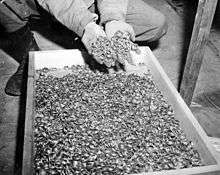Max Heiliger
| Part of a series on | ||||||||||
| The Holocaust | ||||||||||
|---|---|---|---|---|---|---|---|---|---|---|
 | ||||||||||
|
||||||||||
|
Atrocities |
||||||||||
|
Camps
|
||||||||||
|
Lists Deportations of French Jews
to death camps |
||||||||||
|
Remembrance |
||||||||||


Max Heiliger was a fictional name created during the Nazi era under authority of Reichsbank president Walther Funk in a secret arrangement with leader of the Schutzstaffel, Heinrich Himmler. It was a false identity used to establish bank accounts to launder valuables stolen from those killed in the Nazi system of concentration camps and extermination camps.[1] Stolen banknotes and jewelry along with Holocaust victims' dental gold, wedding rings, and even scrap gold melted down from spectacles-frames flooded into the Max Heiliger accounts, completely filling several bank vaults by 1942.[1] Heiliger accounts were also sometimes used to fence valuables at Berlin's municipal pawn shops.[2]
Other code phrases associated with bank-processing of camp victims' property included Melmer, Besitz der umgesiedelten Juden ("property of resettled Jews"), and Reinhardtfonds.[2][3] The latter was a veiled reference to Aktion Reinhardt. The word umgesiedelten cloaked the true nature of the goods, since victims were usually "resettled" to a Nazi concentration camp or an early grave.
Using the name "Heiliger" was a cynical Nazi joke, since the word means saint, from the word heilig (holy).[2] Such "humor" was not unusual in Nazi circles. For example, the one-way path to the gas chamber at Sobibor extermination camp was called Himmelstrasse, meaning "Heaven Street" –the road to Heaven.
References
- 1 2 William L. Shirer (1990) [1960]. Rise and Fall of the Third Reich: A History of Nazi Germany (pg.973). Retrieved Nov 22, 2011.
- 1 2 3 Gábor Kádár and Zoltán Vági (2004). Self-Financing Genocide (pg.118). Retrieved Nov 22, 2011.
- ↑ Yisrael Gutman and Michael Berenbaum (1998). Anatomy of the Auschwitz Death Camp (pg.255). Retrieved Nov 22, 2011.